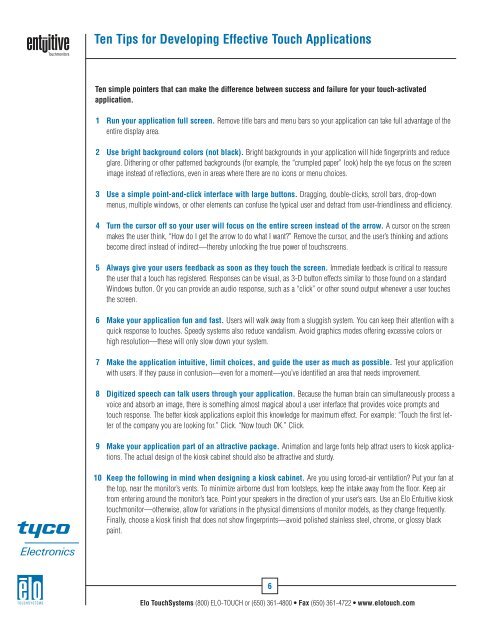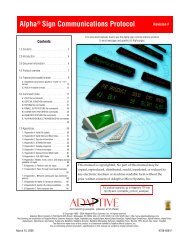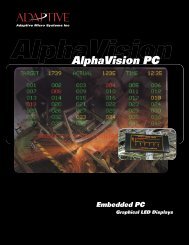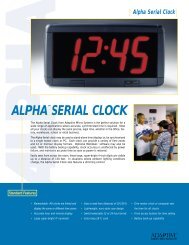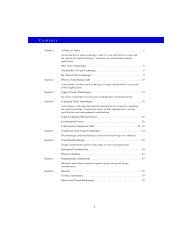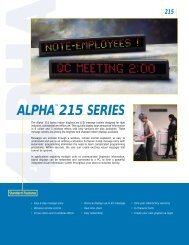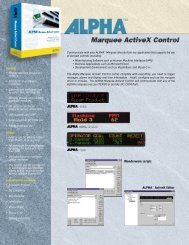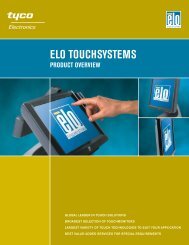Elo U.S. Touchmonitor Catalog - Tek Solutions
Elo U.S. Touchmonitor Catalog - Tek Solutions
Elo U.S. Touchmonitor Catalog - Tek Solutions
Create successful ePaper yourself
Turn your PDF publications into a flip-book with our unique Google optimized e-Paper software.
Ten Tips for Developing Effective Touch Applications<br />
Ten simple pointers that can make the difference between success and failure for your touch-activated<br />
application.<br />
1<br />
2<br />
3<br />
4<br />
5<br />
6<br />
7<br />
8<br />
9<br />
Run your application full screen. Remove title bars and menu bars so your application can take full advantage of the<br />
entire display area.<br />
Use bright background colors (not black). Bright backgrounds in your application will hide fingerprints and reduce<br />
glare. Dithering or other patterned backgrounds (for example, the “crumpled paper” look) help the eye focus on the screen<br />
image instead of reflections, even in areas where there are no icons or menu choices.<br />
Use a simple point-and-click interface with large buttons. Dragging, double-clicks, scroll bars, drop-down<br />
menus, multiple windows, or other elements can confuse the typical user and detract from user-friendliness and efficiency.<br />
Turn the cursor off so your user will focus on the entire screen instead of the arrow. A cursor on the screen<br />
makes the user think, “How do I get the arrow to do what I want?” Remove the cursor, and the user’s thinking and actions<br />
become direct instead of indirect—thereby unlocking the true power of touchscreens.<br />
Always give your users feedback as soon as they touch the screen. Immediate feedback is critical to reassure<br />
the user that a touch has registered. Responses can be visual, as 3-D button effects similar to those found on a standard<br />
Windows button. Or you can provide an audio response, such as a “click” or other sound output whenever a user touches<br />
the screen.<br />
Make your application fun and fast. Users will walk away from a sluggish system. You can keep their attention with a<br />
quick response to touches. Speedy systems also reduce vandalism. Avoid graphics modes offering excessive colors or<br />
high resolution—these will only slow down your system.<br />
Make the application intuitive, limit choices, and guide the user as much as possible. Test your application<br />
with users. If they pause in confusion—even for a moment—you’ve identified an area that needs improvement.<br />
Digitized speech can talk users through your application. Because the human brain can simultaneously process a<br />
voice and absorb an image, there is something almost magical about a user interface that provides voice prompts and<br />
touch response. The better kiosk applications exploit this knowledge for maximum effect. For example: “Touch the first letter<br />
of the company you are looking for.” Click. “Now touch OK.” Click.<br />
Make your application part of an attractive package. Animation and large fonts help attract users to kiosk applications.<br />
The actual design of the kiosk cabinet should also be attractive and sturdy.<br />
10<br />
Keep the following in mind when designing a kiosk cabinet. Are you using forced-air ventilation? Put your fan at<br />
the top, near the monitor’s vents. To minimize airborne dust from footsteps, keep the intake away from the floor. Keep air<br />
from entering around the monitor’s face. Point your speakers in the direction of your user’s ears. Use an <strong>Elo</strong> Entuitive kiosk<br />
touchmonitor—otherwise, allow for variations in the physical dimensions of monitor models, as they change frequently.<br />
Finally, choose a kiosk finish that does not show fingerprints—avoid polished stainless steel, chrome, or glossy black<br />
paint.<br />
6<br />
<strong>Elo</strong> TouchSystems (800) ELO-TOUCH or (650) 361-4800 • Fax (650) 361-4722 • www.elotouch.com


